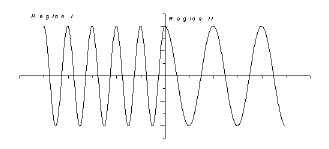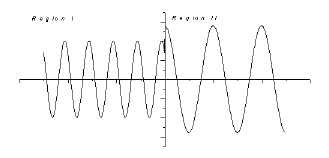- Step 3: At the Boundary A
For the next step we need to consider how to connect the
wave function in region 1 to the one in region 2. We could imagine
several different possibilities. Two are shown below.

(a)

(b)
- In (a) the wave functions connect smoothly, while in (b)
they do not connect. Most people immediately think that (a) looks
better. We will now discuss why “looks better” is correct
in terms of the physics. To understand why, we need to look at
the probability interpretation of the wave function and how that
interpretation affects the wave function when the potential is
changing.
-
- Can you determine the probability of finding the electron
at the boundary in Figure (b)?
-
- You should find this question difficult. At the boundary
the wave function has two different values. Thus, we cannot uniquely
state the probability of an electron being detected there. Therefore,
we must reject this type of wave function because we cannot use
it for determining probabilities. (We recommend that you draw
a big X through (b). Click ing here will remind you that it is
not acceptable.





